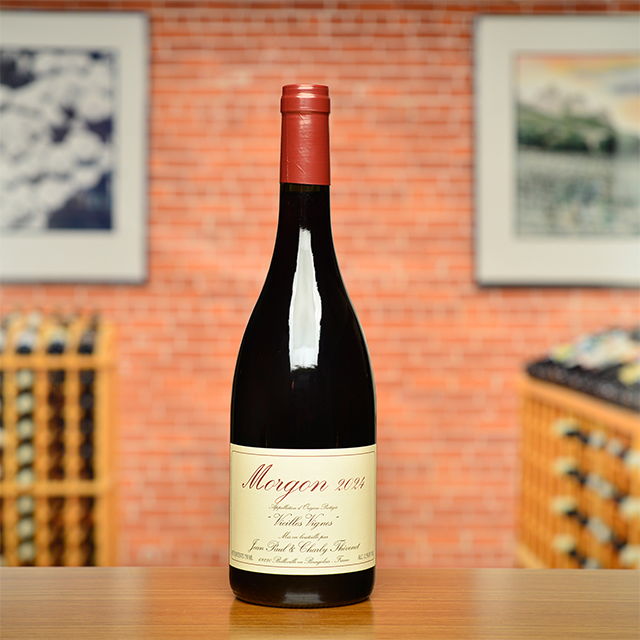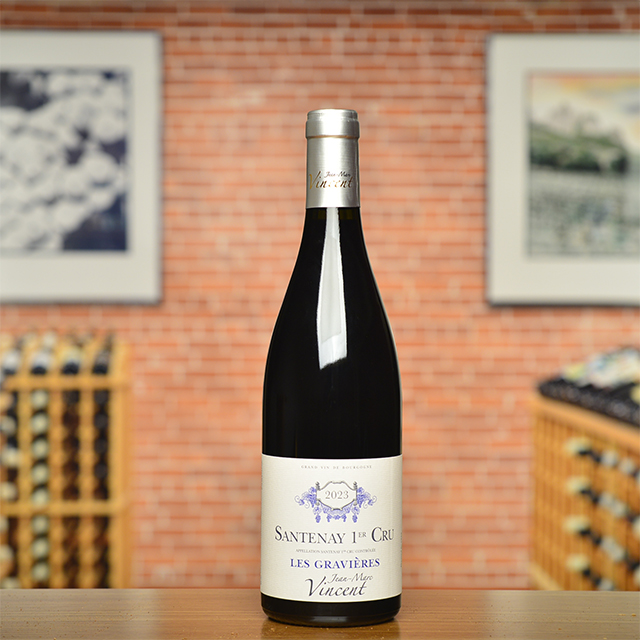Notify me
2021 Beaujolais Blanc “Terrain Rouge”
Jean-Paul et Charly Thévenet
Chardonnay doesn’t spring to mind upon hearing the name Thévenet, a domain known for elegant, unadulterated Gamay from Régnié and Morgon. But a surprising blanc emerges from a small parcel rich with red clay soil, aptly named “Terrain Rouge.” In classic Thévenet fashion, the wine is bright and energetic—a snappy Beaujolais Blanc that tastes like fresh green apple skin with a whisper of gentian.
—Allyson Noman
| Wine Type: | white |
| Vintage: | 2021 |
| Bottle Size: | 750mL |
| Blend: | Chardonnay |
| Appellation: | Beaujolais |
| Country: | France |
| Region: | Beaujolais |
| Producer: | Jean-Paul et Charly Thévenet |
| Winemaker: | Jean-Paul & Charly Thévenet |
| Vineyard: | 6 years old, .5 ha |
| Soil: | Clay, Limestone |
| Farming: | Biodynamic (practicing) |
| Alcohol: | 12.5% |
More from this Producer or Region

2023 Moulin-à-Vent “Sous la Roche”
France | Beaujolais
It combines the structural grandeur typical of Moulin-à-Vent with a high-elevation freshness.

2024 Régnié “Grain & Granit”
France | Beaujolais
Here is a rich, bold Régnié, saturated with luscious fruit and earthy spice.

2024 Morgon “Vieilles Vignes”
France | Beaujolais
December Club Rouge ~ If Beaujolais were Burgundy, we might consider Morgon to be Vosne-Romanée, with its haunting perfume and silky texture, the proverbial iron fist in a velvet glove.

2023 Beaujolais Blanc “Clos de Rochebonne”
France | Beaujolais
Rochebonne offers Chardonnay fruit that’s both racy and sun-kissed

2023 Chénas “Chassignol”
France | Beaujolais
A finessed, mineral-driven beauty from hundred-year-old vines at the highest point in Chénas.

2024 Chiroubles “Cuvée Léa”
France | Beaujolais
Floral and succulent, bursting with notes of little red berries, but it is also delicate and light on its feet.

2023 Chénas “Les Blémonts”
France | Beaujolais
Structured yet full of energy, with notes of blueberry, spice, and other things nice.

2024 Morgon
France | Beaujolais
The domaine’s flagship bottling, crafted from vines averaging sixty years old; inviting aromatics, succulent flesh, juicy finish.

2024 Beaujolais Blanc
France | Beaujolais
Do not miss this outstanding, value-driven Chardonnay from one of our most beloved French domaines.

2024 Morgon “La Roche Pilée”
France | Beaujolais
This is textbook Morgon: bright, floral, and spicy, recalling juicy peach and sour cherry.
About The Producer
Jean-Paul et Charly Thévenet
Jean-Paul Thévenet is the third generation to produce wine at his family estate in Morgon, but as a young man he took the domaine in an unexpected direction. In the early 1980s Beaujolais was flooded with commercialized wine, pushing winemaker and viticultural prophet Jules Chauvet to invoke a return to more traditional practices. Jean-Paul and three other local vignerons, Marcel Lapierre, Guy Breton, and Jean Foillard, soon took up the torch of this “natural wine” movement.
Known as “Paul-Po” among friends, Jean-Paul is reserved yet fun-loving. He farms his small five-hectare domaine with his son, Charly, and since 2008 the two have taken the domaine to the next level by adopting organic and biodynamic viticultural practices.
About The Region
Beaujolais

After years of the region’s reputation being co-opted by mass-produced Beaujolais Nouveau and the prevalence of industrial farming, the fortunes of vignerons from the Beaujolais have been on the rise in the past couple of decades. Much of this change is due to Jules Chauvet, a prominent Beaujolais producer who Kermit worked with in the 1980s and arguably the father of the natural wine movement, who advocated not using herbicides or pesticides in vineyards, not chaptalizing, fermenting with ambient yeasts, and vinifying without SO2. Chief among Chauvet’s followers was Marcel Lapierre and his three friends, Jean Foillard, Guy Breton, and Jean-Paul Thévenet—a group of Morgon producers who Kermit dubbed “the Gang of Four.” The espousal of Chauvet’s methods led to a dramatic change in quality of wines from Beaujolais and with that an increased interest and appreciation for the AOC crus, Villages, and regular Beaujolais bottlings.
The crus of Beaujolais are interpreted through the Gamay grape and each illuminate the variety of great terroirs available in the region. Distinguishing itself from the clay and limestone of Burgundy, Beaujolais soils are predominantly decomposed granite, with pockets of blue volcanic rock. The primary vinification method is carbonic maceration, where grapes are not crushed, but instead whole clusters are placed in a tank, thus allowing fermentation to take place inside each grape berry.
Much like the easy-going and friendly nature of many Beaujolais vignerons, the wines too have a lively and easy-drinking spirit. They are versatile at table but make particularly good matches with the local pork sausages and charcuterie. Though often considered a wine that must be drunk young, many of the top crus offer great aging potential.
More from Beaujolais or France
2024 Côte de Brouilly
Château Thivin France | Beaujolais
2024 Régnié “Grain & Granit”
Jean Paul et Charly Thévenet France | Beaujolais
2024 Morgon “La Roche Pilée”
Jean-Paul et Charly Thévenet France | Beaujolais
2022 Régnié
Guy Breton France | Beaujolais
2024 Côte de Brouilly MAGNUM
Château Thivin France | Beaujolais
2024 Moulin-à-Vent “Vieilles Vignes”
Bernard Diochon France | Beaujolais
2023 Beaujolais Blanc “Clos de Rochebonne”
Château Thivin France | Beaujolais
2023 Fleurie
Jean Foillard France | Beaujolais
2024 Morgon “Vieilles Vignes”
Jean-Paul et Charly Thévenet France | Beaujolais
2023 Chénas “Vibrations”
Domaine Thillardon France | Beaujolais
2024 Morgon “Vieilles Vignes”
Guy Breton France | Beaujolais
2022 Côte de Brouilly
Guy Breton France | Beaujolais
2024 Côte de Brouilly
Château Thivin France | Beaujolais
2024 Régnié “Grain & Granit”
Jean Paul et Charly Thévenet France | Beaujolais
2024 Morgon “La Roche Pilée”
Jean-Paul et Charly Thévenet France | Beaujolais
2022 Régnié
Guy Breton France | Beaujolais
2024 Côte de Brouilly MAGNUM
Château Thivin France | Beaujolais
2024 Moulin-à-Vent “Vieilles Vignes”
Bernard Diochon France | Beaujolais
2023 Beaujolais Blanc “Clos de Rochebonne”
Château Thivin France | Beaujolais
2023 Fleurie
Jean Foillard France | Beaujolais
2024 Morgon “Vieilles Vignes”
Jean-Paul et Charly Thévenet France | Beaujolais
2023 Chénas “Vibrations”
Domaine Thillardon France | Beaujolais
2024 Morgon “Vieilles Vignes”
Guy Breton France | Beaujolais
2022 Côte de Brouilly
Guy Breton France | Beaujolais
Kermit once said...

Kermit once said...
For the wines that I buy I insist that the winemaker leave them whole, intact. I go into the cellars now and select specific barrels or cuvées, and I request that they be bottled without stripping them with filters or other devices. This means that many of our wines will arrive with a smudge of sediment and will throw a more important deposit as time goes by, It also means the wine will taste better.
















